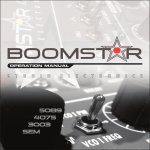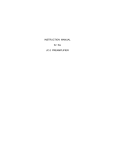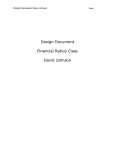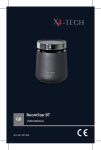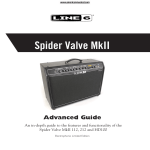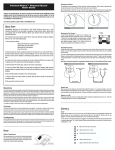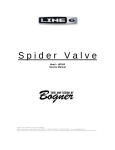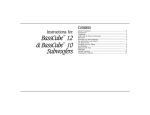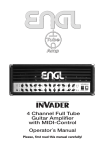Download ANALOGIA BOOMSTAR Specifications
Transcript
!! !! !! !! !! !! ! 3003 5089 4075 FULL FREQUENCY RESONANCE FULL FREQUENCY ! HALF TRACK AMP RESONANCE FREQUENCY HALF TRACK RESONANCE INPUT HALF TRACK STAGE 1/2 FREQ CV 1 BOOMSTAR MODULAR SYNTHESIZER SYSTEM ! ! ! ! ! FREQ CV 1 RESO CV FREQ CV 1 RESO CV DRONE MODSTAR RESONANT FILTER and RESO CV STAGE 2/2 FREQ CV 2 FREQ CV 2 FREQ CV 2 AMP OPERATION MANUAL DRIVE INPUT 1 V/O INPUT OUTPUT FREQ CV 1 FREQ CV 2 OUTPUT INPUT RESO CV 1 V/O OUTPUT INPUT OUTPUT FREQ CV 1 FREQ CV 2 OUTPUT INPUT RESO CV 1 V/O OUTPUT INPUT OUTPUT OUTPUT FREQ CV 1 FREQ CV 2 OUTPUT RESO CV INPUT ST 1/1 ST 1/2 OUTPUT ST 2/1 ST 2/2 OUTPUT IMPORTANT INSTRUCTIONS - PLEASE READ ! ! ! Please read the Boomstar Modular Synthesizer Manual completely before use, and retain for future reference. ! IMPORTANT Ribbon Cable Power Information: Boomstar Modular combines a set of individual modules to create a complete instrument. The individual modules can be rearranged, removed, and replaced with any compatible eurorack modules from Studio Electronics and other manufacturers. ! Boomstar Modular uses a standard eurorack power rail to connect the modules to the internal bipolar +/-12v power supply. Please pay very close attention to the orientation of the ribbon cable when adding and removing modules. The stripe on the ribbon cable marks -12v. This stripe needs to line up with the -12v pins on the power rail and the -12v pins on the module. Failure to match up the pins correctly can result in damage to one or all the modules in the Boomstar Modular. On the power rail, the -12v pins are clearly labeled. On the individual modules, the positive and negative sides of the pin connectors are labeled next to the power header on either the top or bottom of the PCB. ! Do NOT remove individual modules from the Boomstar while synthesizer is plugged in. ! NEVER unplug ribbon cables from the Boomstar Modular, or any other modules while the Boomstar Modular is plugged in. ! ! ! i Table of Contents ! ii !! Box Contents ..………………………….……….………………………………….…… 1 Dimensions & Power Specifications ……………………………………………… 2-3 Boomstar Modular Introduction ………………………………………….………… 4 Modular Signal Paths ………………………….……………………………….…….. 5 Complete MODSTAR Systems ………………..….……………………………..….. 6-8 Individual Modules …………….……………….……………………………………… 9-24 1 Year Limited Warranty ……………………………………………………….…….. 25-26 Support & Contact ……………………………………………………………………… 27 Box Contents Module(s) of choice 1x Ribbon Cable 1x Information Card 1 ! ! DIMENSIONS & POWER SPECIFICATIONS ! Filters 5089 – Size: 12hp Module depth with ribbon cable attached: 39.7mm +12 / -12 Power Usage: 40mA, 28mA ! 4075 – Size: 12hp Module depth with ribbon cable attached: 39.7mm +12 / -12 Power Usage: 23mA, 30mA ! 3003 – Size: 12hp Module depth with ribbon cable attached: 39.7mm +12 / -12 Power Usage: 37mA, 25mA ! SEM – Size: 12hp Module depth with ribbon cable attached: 39.7mm P +12 / -12 Power Usage: 23mA, 23mA ! ! ! 2 Amplifier DIMENSIONS & POWER SPECIFICATIONS - 2 AMP – Size: 8hp Module depth with ribbon cable attached: 39.7mm +12 / -12 Power Usage: 36mA, 12mA ! Analog Oscillator OSCILLATION – Size: 48hp Module depth with ribbon cable attached: 39.7mm Power Usage: ! Digital Oscillator GRAINY CLAMP-IT – Size: 19hp Module depth with ribbon cable attached: 35mm Power Usage: 50mA max ! 3 Boomstar Modular Introduction THE BOOMSTAR MODULAR SYSTEM realizes the seemingly inevitable eurorack sprawl of our semi-modular BOOMSTAR desktop synth, consisting of 14 modules that dramatically open up the root level programming and sound sculpting of that lush, potent, and fantastically flexible multi-filtered Boomstar sound. ! What makes it tick: Let’s tick ‘em off: Class A 5089, 3003 and AMP *, rugged through-hole construction, discrete circuitry, hand-matched transistors in the filters and amplifier, multi-filtered, hand-crafted, Premium Quality Analog sound. We’d like to think we’ve learned a few things bringing the MIDIMINI, SE1-X, ATC-X, polyphonic CODE OMEGA synths, MODMAX PEDALS, C2S, PRE 2, and SLATE PRO AUDIO DRAGON and FOX to market, and the air waves worldwide. ! Our Boomstar Modular System’s (Modstar) 5089 circuit mirrors faithfully the filter design from the Minimoog—it is not a style; it’s not a type, not reminiscent of, not vintage inspired—it is the analog sound standard manufactured anew, and how we love it so. Apply the same thinking to our 4075, 3003, and SE80 filters vis-à-vis their originals, and you’ve caught our drift; the OSCILLATION and AMP modules also resonate with the Mini’s timeless designs, functionality, and gorgeous, gleaming sound— modernized and reimagined by the maestro Tim Caswell himself, but we’re just getting started here; the SEM filter is on deck. ! We hope you are as thrilled with your purchase of the complete system/individual modules as we are with our partnership with PITTSBURGH MODULAR, and the final highly collaborative through-hole designs which flowed from the first Nicol/St. Regis Beer Summit at Winter NAMM ’13. The MODSTAR module breakdown upshot: Filters, Oscillators, and AMP are built by SE, and the intoxicating remainder by our good friends and exceedingly savvy business partners at PGH—without whose invaluable, real world/walking the streets of Euroland insights, experience, and deep resources, this project would have faded to grey. A tip of the SE chapeau to Richard Nicol, Perry, and the full-strength, generally less-weathered outfit at P. M. AND to Geoff Farr who relentlessly hounded the St. Regis bros—“When are the euro modules going to be ready?” Looks. * See pg.17, par. 2 for caveat. 4 Modular Signal Paths (Copy courtesy of Pittsburgh Modular) ! The BOOMSTAR MODULAR’S signal path is divided into two types of signals: audio signals and control voltages. ! The audio signal is the sound that is produced. The audio signal path starts at a sound source such as a Waveforms oscillator, LFO running at audio rate, or the Filter in oscillator mode. The audio signal is then patched through other modules used to shape the sound such as mixers, filters, and amplifiers. ! Control voltages (CV) manipulate the audio signal in several different ways. ! Gates are represented by a high or low control voltage. A gate can be generated using a square or pulse wave from an oscillator or LFO, or by using a gate output from an external sequencer, or MIDI keyboard. A gate can be shaped using an envelope generator to control the attack, decay, sustain, and release of the gate. The modified gate signal can then be sent to any CV input on the synth. ! A second use for control voltages is as a modulation source. For example, a control voltage from the SCI-FI S/H OUT (Sample and Hold) module patched into the 1V/O input on an OSCILLATION module controls the frequency of the oscillator based on the randomly generated sequence of notes, additionally, the OSCILLATION module’s full range oscillators make perfect control voltage modulation sources; and audio signals make excellent control voltage source for oscillator FM (frequency modulation). Understanding exactly how it works can sometimes hinder creativity—experiment! ! 5 Boomstar Modular MODSTAR SEITO MODSTAR SEITO 104 hp: MIDI 3 6hp, OSCILLATION (x2) 32hp, 4075 12hp, MULTIPLE 2hp, LEVELS 10hp, SCI-FI 10hp, SHAPERS 12hp, AMP 8hp, LFO2 6hp, OUTS 6hp. Hugged-up nicely in Pittsburgh Modular’s Move 104 Mobile Eurorack Modular Case, to safely house and power it up. Hand-built in Pittsburgh using select Ukrainian Birch Ply, it celebrates the classic pairing of synthesizers with beautiful hardwood—constructed and stained by seasoned craftsmen to emphasize its unique beauty. Each Move case includes a removable lid; when attached, the lid fits over the patch cables allowing your fully patched modular to hit the road. 6 Boomstar Modular MODSTAR SENSEI 7 ! ! Boomstar Modular MODSTAR SENSEI - 2 MODSTAR SENSEI 178 hp: OSCILLATION (x3) 48hp, MULTIPLE 2hp, 5089 12hp, 4075 12hp, SE88 20hp, LEVELS 10hp, MIDI 3 6hp, LFO2 6hp, LFO B 6hp (LFO2 pictured), LEVELS 10hp, SCI-FI 10hp, SHAPERS 12hp, MULTIPLE 2hp, MODSTAR BEAUTY PLATE 18hp, SHAPERS 12hp, AMP (x2) 16hp, 6hp, OUTS 6hp. Double hugged in Pittsburgh Modular’s Move 208 Mobile Eurorack Modular Case.* ! ! *Sensei specs. subject to change. MODELS NOW SHIPPING DETAILED BELOW. 8 5089 Filter Module Description The 5089 filter is a voltage controlled, discrete analog, 24 db/oct transistor ladder, low-pass filter, employing hand-matched transistors. Our ladder low-pass filter—a subtractive analog sound synthesis foundation—in its lowest FREQUENCY setting removes, or cuts off higher frequency harmonics; its RESONANCE or Q circuit emphasizes those harmonics to the point of “squealy,” giddy self-oscillation, tracking the keyboard in its FULL setting quite nicely if seeking an alternative sine wave. ! Our 5089 has the roundest, slickest tone of all the Boomstar’s filters. Go easy on it, and round, creamy buttery flavors wrap the oscillators in earthy warmth; smash it and a meaty, satisfying overdrive, and a maximum harvest of vintage 1960s and 1970s organic-sounding, second-order harmonic distortion fill the plate. Every setting is balanced and bountiful. Looking for traditional R ’n B baselines and leads? Focus here on the rich saturation of this benchmark filter and its symmetrical cascades of generation-stretching timbres. All BOOMSTAR MODULAR filters are hand-built in the U. S. Pick-and-Place all the way! ! Potentiometer Potential Three attenuverter and four attenuation pots control the FREQUENCY, RESONANCE, FREQ CV 1, RESO CV, FREQ CV 2, INPUT and OUTPUT, delivering smooth, detailed, and complex expression. ! Switch It Up !Classic Minimoog FULL and HALF strength filter frequency keyboard/voltage tracking for rounder low end with brilliant highs. ! Patch It Up Seven patch points: 1 V/O, FREQ CV 1, FREQ CV 2, RESO CV, INPUT and 2x OUTPUT direct the deepest manipulation. 9 5089 Filter Module - 2 All Controls and Patch Points FREQUENCY – Adjusts the frequency, or cut-off of the filter. RESONANCE – Adjusts the resonance, or “Q” of the filter. * FULL HALF TRACK – Switch between full and half keyboard/voltage tracking. FREQ CV 1 – Frequency control voltage 1 input attenuverter. RESO CV – Resonance control voltage input attenuverter. FREQ CV 2 – Frequency control voltage 2 input attenuverter. INPUT – Adjusts the audio input. OUTPUT – Adjusts the audio output. 1 V/O – One volt per octave control voltage input. FREQ CV 1 – Frequency control voltage 1 input. FREQ CV 2 – Frequency control voltage 2 input—get tricky with the second attempt. RESO CV – Resonance control voltage input—use for shimmers or howling wolf tones. INPUT – Audio input. 2x OUTPUT – Audio outputs. ! * From 7:00 (0) to 9:00 our “Negative Resonance Saturation” adds beefiness, boosting the waveform amplitude and taming waveform transients; set to 9:00 to achieve the cleanest tone possible. 10 4075 Filter Module Description The 4075 filter is a voltage controlled, discrete analog, 24/db/oct cascaded transconductance low-pass filter, employing handmatched transistors. In its lowest FREQUENCY setting it shaves off higher frequency harmonics; its RESONANCE or “Q” circuit pushes those harmonics past the self-oscillation boiling point, projecting a thumpy, thrashing squeal, with explosive low to mid-range power and depth. The design is actually pulled from the four-pole ARP 4072 (better: more parts and trims), sans the 12kHz design flaw which hamstrung the original’s high end. The 4075 name has stuck—no correcting our little misnomer. ! Our 4075 filter is the most requested of the Boomstar filter models, perhaps owing to its uniqueness. Has there ever been a better match for a square wave? It weaves dreams with “glidey,” 70s basslines, is a natural in the lead department, and feels as if a temper tantrum simmers a mere micron beneath its veneer of faux respectability. Aggressive and articulate, this fresh ARP can snap punishing kick drum sounds out as well as color with bright, edgy, stringy tones for essential arpeggiations. ! Potentiometer Potential Three attenuverter and four attenuation pots control the FREQUENCY, RESONANCE, FREQ CV 1, RESO CV, FREQ CV 2, INPUT and OUTPUT, delivering smooth, detailed, and complex expression. ! Switch It Up !Classic Minimoog FULL and HALF strength filter frequency keyboard/voltage tracking for rounder low end with brilliant highs. ! Patch It Up Seven patch points: 1 V/O, FREQ CV 1, FREQ CV 2, RESO CV, INPUT and 2x OUTPUT direct the deepest manipulation. 11 4075 Filter Module - 2 All Controls and Patch Points FREQUENCY – Adjusts the frequency, or cut-off of the filter. RESONANCE – Adjusts the resonance, or “Q” of the filter. * FULL HALF TRACK – Switch between full and half keyboard/voltage tracking. FREQ CV 1 – Frequency control voltage 1 input attenuverter. RESO CV – Resonance control voltage input attenuverter. FREQ CV 2 – Frequency control voltage 2 input attenuverter. INPUT – Adjusts the audio input. OUTPUT – Adjusts the audio output. 1 V/O – One volt per octave control voltage input. FREQ CV 1 – Frequency control voltage 1 input. FREQ CV 2 – Frequency control voltage 2 input—get tricky with the second attempt. RESO CV – Resonance control voltage input—use for shimmers or howling wolf tones. INPUT – Audio input. 2x OUTPUT – Audio outputs. ! * From 7:00 (0) to 9:00 our “Negative Resonance Saturation” adds beefiness, boosting the waveform amplitude and taming waveform transients; set to 9:00 to achieve the cleanest tone possible. 12 3003 Filter Module Description The 3003 filter is a voltage controlled, discrete analog 18 db/oct ladder low-pass filter, employing hand-matched transistors. Drop the FREQUENCY knob to 0 and things get pretty dull; swing it back up and those "Transistor Bass” highs come crashing through the gate. The 3003’s RESONANCE circuit at max will sing out more than the TB’s signature chirping in a fun, bubbly, if washy, poorer relation, Mini “clone-ish" way; use it tastefully, or throw moderation to the wind for overwhelming chirp force. ! Our 3003 filter has the most gentle sonic touch of its partners in the Boomstar fold, but nevertheless is quite capable of shaping precise, very dynamic tone. Whether or not this STUDIO ELECTRONICS filter is filling its traditional baseline boxing niche, driving a harsh, liquid, acid-like tone, a softer more rubber-bandy SH-101-ish presence, or out of the bass range altogether, leading the way, all is within easy reach of this surprisingly warm and versatile VCF. The 3003 can be distinctly vocal at times, especially when one is willing to put grittier, more distorted desires aside. ! Potentiometer Potential Three attenuverter and four attenuation pots control the FREQUENCY, RESONANCE, FREQ CV 1, RESO CV, FREQ CV 2, INPUT and OUTPUT, delivering smooth, detailed, and complex expression. ! Switch It Up !Classic Minimoog FULL and HALF strength filter frequency keyboard/voltage tracking for rounder low end with brilliant highs. ! Patch It Up Seven patch points: 1 V/O, FREQ CV 1, FREQ CV 2, RESO CV, INPUT and 2x OUTPUT direct the deepest manipulation. 13 3003 Filter Module - 2 All Controls and Patch Points FREQUENCY – Adjusts the frequency, or cut-off of the filter. RESONANCE – Adjusts the resonance of the filter. * FULL HALF TRACK – Switch between full and half keyboard/voltage tracking. FREQ CV 1 – Frequency control voltage 1 input attenuverter. RESO CV – Resonance control voltage input attenuverter. FREQ CV 2 – Frequency control voltage 2 input attenuverter. INPUT – Adjusts the audio input. OUTPUT – Adjusts the audio output. 1 V/O – One volt per octave control voltage input. FREQ CV 1 – Frequency control voltage 1 input. FREQ CV 2 – Frequency control voltage 2 input—get tricky with the second attempt. RESO CV – Resonance control voltage input—use for shimmers or howling wolf tones. INPUT – Audio input. 2x OUTPUT – Audio outputs. ! * From 7:00 (0) to 9:00 our “Negative Resonance Saturation” adds beefiness, boosting the waveform amplitude and taming waveform transients; set to 9:00 to achieve the cleanest tone possible. 14 Description SEM Filter Module Sensei Caswell: "Our SEM is known as a "Voltage Controlled State Variable Filter" because it provides simultaneous high pass, low pass, and band pass outputs, all with a 12 dB/oct slope. The notch is the inverse of the bandpass, achieved by summing the Low Pass and high pass outputs. This version is a combination of the original SEM filter and the newer design from the OBX, along with improvements by SE. It has a modest current draw, evenly from the plus and minus rails." ! If you've heard the SEM filter in our Boomstar desktop (https://soundcloud.com/studio-electronics/sets/mean-sem-ranch/) you also know that this 12 dB favorite is “… capable of lighter, more subtle tones than the other three models. This isn't to suggest the filter's Low Pass mode can't cater for fat and punchy, because it can." - Paul Nagle, Sound on Sound. Deeply gratifying tonal variance and this emotional warmth https://soundcloud.com/alanc3-1/switched-on-sem—our friend Fred Falke's favorite—can reach into your head and heart, and stay as long as desired. Thank you Lord Tom Oberheim for this marvelous design/template from which we were able to work our very own Studio Electronics eurorack filter enchantments. ! Potentiometer Potential Three attenuverter and four attenuation pots control the FREQUENCY, RESONANCE, FREQ CV 1, RESO CV, LP HP, INPUT and OUTPUT, delivering smooth, detailed, and ever variable expression. ! Switch Up !FULL andItHALF strength filter frequency keyboard/voltage tracking, and BP / LP-HP modes. ! Patch It Up Seven patch points: 1 V/O, FREQ CV 1, FREQ CV 2, RESO CV, INPUT, BP LP-HP, and OUTPUT jack you in. 15 All Controls and Patch Points SEM Filter Module - 2 FREQUENCY – Adjusts the frequency, or cut-off of the filter. RESONANCE – Adjusts the resonance of the filter. * FULL HALF TRACK – Switch between full and half keyboard/voltage tracking. FREQ CV 1 – Frequency control voltage 1 input attenuverter. RESO CV – Resonance control voltage input attenuverter. FREQ CV 2 – Frequency control voltage 2 input attenuverter. INPUT – Adjusts the audio input. OUTPUT – Adjusts the audio output. 1 V/O – One volt per octave control voltage input. FREQ CV 1 – Frequency control voltage 1 input. BP OUT – Band Pass Output. No cable patched, BP passes through the mains. RESO CV – Resonance control voltage input—use for shimmers or howling wolf tones. LP HP – Low Pass / High Pass attenuverter. INPUT – Audio input. OUTPUT – Audio output. ! * From 7:00 (0) to 9:00 our “Negative Resonance Saturation” adds beefiness, boosting the waveform amplitude and taming waveform transients; set to 9:00 to achieve the cleanest tone possible. 16 AMP Module Description From Designer Tim Caswell’s own hand: The amplifier (AMP) is a 2 stage Class A discrete design using three pairs of hand matched transistors. Envelope is usually applied to ST1 CV1; ST1 CV2 goes thru an attenuverter and can be used for envelope or modulation; ST2 CV1 goes to the 2nd stage, and is typically used for volume control; ST2 CV2 goes thru an attenuverter providing access to the final stage of modulation input. ! The AMP, the 5089, and the 3003 are Class A circuits. They draw more current from the +12 rail than from the -12 volt rail. If the system power supply is under-sized, hum or buzz may be heard. In that case, larger filter capacitors and/or a larger power transformer will be needed. The 4075 draws equally from both rails, and is more immune to hum. Like our time-perfected filters, this Boomstar Modular AMP module, a gorgeous all-in-one discrete VCA charmer, is hand-built entirely in the U. S. of A—just ask Rachael Herbison! ! Potentiometer Potential Two attenuverter, and two attenuation pots control the INPUT, ST1 CV2 (CV), ST2 CV2 (CV), and OUTPUT. ! Switch It Up Uber-useful continuous hypnotic DRONE for endless sustain/release, and DRIVE—the overdrive circuit from the Boomstar desktop—for last stage push, clipping, good ol' dirty vintage fuzz fun, and tone-crushed distortion. ! Patch It Up Six patch points: INPUT, ST1 CV1, ST1 CV2, ST2 CV1, ST2 CV2, OUTPUT direct the deepest manipulation. 17 ! AMP Module All Controls and Patch Points INPUT – Adjusts the audio input. ST1 CV2 (formerly STAGE 1/2) – Adjusts stage 1, control voltage 2 (CV). ST2 CV2 (formerly STAGE 2/2) – Adjusts stage 2, control voltage 2 (CV). DRONE – Sustains the last note received—“Hold that Train.” DRIVE – Final output stage saturation/overdrive—absolutely smash the input, and back down the output level for classic guitar amp “master volume” crunch savagery, and last gasp volume control if so inspired. OUTPUT – Adjusts the audio output. INPUT – Audio input. ST1 CV1 (formerly ST 1/1) – Stage 1, control voltage 1 input (CV). ST1 CV2 (formerly ST 1/2) – Stage 1, control voltage 2 input (CV). ST2 CV1 (formerly ST 2/1) – Stage 2, control voltage 1 input (CV). ST2 CV2 (formerly ST 2/2) – Stage 2, control voltage 2 input (CV). OUTPUT – Audio output. ! 18 OSCILLATION Module Description Tim Caswell unplugged: “Another hybrid, utilizing an exponential current source similar the the ones from ARP and Oberheim, followed by wave shaping circuits adapted from the 2nd generation MiniMoog oscillator board, and incorporating waveform mixing circuits pioneered by SE. This provides a large variety of tones that would otherwise require several patch cords and an external mixer. With a two oscillator system, that's 9 or 10 patch cords and an 8 input mixer. Modest current draw, evenly from plus and minus.” ! TC continuing: “What’s nice about our OSCILLATION stunner is that “the waveforms are DC-coupled [components connected directly together without coupling capacitors], so they keep their shape even at sub-Hz speeds. The outputs are also buffered, so the amplitude is independent of the load they are driving. The waveform levels on some modern eurorack OSCs are often all different, and they vary depending if they go into the mixer or directly to the filter!” Coupling the circuitry without capacitors in-line allows the full spectrum of sound frequencies to pass through. ! Potentiometer Potential Three attenuverter and four attenuation pots control the FREQUENCY, TUNE, PW CV IN, PUSLE WIDTH, FM CV IN, and SUB LEVEL for smooth, detailed, and complex expression, and sweeping expression. ! Switch It Up NORMAL and LOW RANGE - wide sweeping audio frequencies, or clicks (respectively) for creating a rhythmic pulse or sweep; SINE, TRI, SAW, SQR - your friendly waveform on and offs. 19 ! OSCILLATION Module - 2 Patch It Up Six patch points: INPUT, ST1 CV1, ST1 CV2, ST2 CV1, ST2 CV2, OUTPUT direct the deepest manipulation. ! All Controls and Patch Points INPUT FREQUENCY – Oscillator frequency attenuator. NORMAL / LOW RANGE – Oscillator domain switch. TUNE – Oscillator fine-tune attenuverter. PULSE WIDTH – Variable pulse wave width control. SINE – Sine wave on/off. TRI – Triangle wave on/off. SAW – Sawtooth wave on/off. SQR – Square (pulse) wave on/off. FM CV IN – Frequency Modulation control voltage input attenuverter. SUB LEVEL – Sub (one octave down) level attenuator. 1 V/O – One volt per octave control voltage input. FM IN – Frequency Modulation control voltage input. SYNC IN – Oscillator Sync control voltage input. PW IN – Pulse Width control voltage input. 20 SUB OUT – Sub Oscillator output. SINE OUT – Sine Oscillator output. TRI OUT – Triangle wave output. SAW OUT – Sawtooth wave output. RAMP OUT – Ramp (reverse sawtooth) wave output. SQR OUT – Square wave output. ! 21 OSCILLATION Module - 3 ! GRAINY CLAMP-IT Description GRAINY CLAMP-IT is a granular and phase modulated additive oscillator—brand new heavy territory for Studio Electronics... we know; wait till you hear the stunning contrast it creates when paired with our discrete Class-A OSCILLATION module, and the inorganic to downright 1970's combo organy / CS-80-ish tones it can generate. Pure voltage-controlled candy. Be sure to wash off the sticky... ! Best to break Granny Clampett's namesake down in stages, and time travel a bit. ! First Stage - Additive mixing of 4 harmonics using one of 16 waveforms, and one of 16 combinations of harmonics. ! Second Stage - Granular or phase modulated mixing of the signal from the first stage, with a sync option. ! Back to the First Stage - Additive section with selection of 16 different combinations of harmonics. The harmonics can be based on a sinewave or on one of 15 other waveforms. There's a separate control for mixing the selected harmonics. ! Back to the Second Stage - The second processing stage allows granular processing or phase distortion. Granular processing gives you control over grain length and grain position, and can produce sync, detune, and wave sequencing effects. Phase distortion allows the signal from stage one to "look up" non-linearly, and can produce thick detune sounds and wildly varying pitch/timbre effects. 22 ! GRAINY CLAMP-IT - 2 Patch It Up Five patch points: 1V/OCT, L/P CV, OMX CV, S/A CV, OUTPUT. ! All Controls— arranged in order of signal flow —and Patch Points WAVE TYPE – Selects one of 16 source waveforms. OT TYPE – Combines 4 copies of the Wave Type – selects one of 16 variations of four overtones. OT MIX – Controls the mix of the four overtones, from lowest pitched to highest pitched dominance. DETUNE – Combines the resulting mix with a copy of itself and detunes it up to one octave. GRAIN/PD – Selects the next processing stage: Up: Granular, or Down: Phase Distortion. GRAIN LEN/PITCH – Sets the grain length, for pitch and sync effects. SPACE/AMT – Sets the spacing between grains, for detune/wave-sequence effects. FIX – Up: Len/Pitch controls pitch; Down: Len/Pitch controls sync. RANGE – Up: Grain sample window is long, for wave sequencing (set Space Amt to 0 ); Down: Grain sample window is short, for detune effects. PD LEN/PITCH – Controls the pitch of the processed sound. SPACE/AMT – Controls the amount of phase distortion. 23 GRAINY CLAMP-IT - 3 FIX – Up: the pitch control of Len/Pitch is continuous; Down: Len/Pitch selects a range of fixed pitches. RANGE – Up: PD sample window is long, for wave sequencing; Down: PD sample window is short, for detune effects. 1V/OCT – One volt per octave control voltage input. L/P CV – Length/Pitch control voltage. OMX CV – Oscillator Mix control voltage. S/A CV – Space Amount control voltage. OUTPUT – Audio Output. 24 1 Year Limited Warranty LIMITED WARRANTY TERMS AND CONDITIONS This Limited Warranty applies only to ANALOGIA INC./STUDIO ELECTRONICS purchased in the United States of America. Outside the USA, warranty policy and service is determined by the laws of the country of purchase and followed by our local authorized distributor. A listing of our authorized distributors is available at http://www. studioelectronics.com/shop/distributors/ ANALOGIA INC./STUDIO ELECTRONICS warrants to the first owner of a covered product purchased directly from ANALOGIA INC./STUDIO ELECTRONICS, or an authorized ANALOGIA INC./STUDIO ELECTRONICS dealer in the U.S., that this product will be free from defects in materials and or workmanship for a period of one year from the date of purchase. Please register this product online at http://studioelectronics.com/support/ registration/ to establish the date of purchase (NOT A REQUIREMENT FOR WARRANTY SERVICE BUT A GOOD IDEA). To exercise your rights under this Warranty as the first owner/purchaser, YOU MUST SHIP THIS PRODUCT IN ITS ORIGINAL PACKAGING (which we can replace and send to you for $10) at your expense, with proof of purchase documentation and the ANALOGIA INC./STUDIO ELECTRONICS supplied power adapter, to ANALOGIA INC. An RMA (Return Material Authorization) number from ANALOGIA INC./STUDIO ELECTRONICS must be obtained first before returning any product. Email RMA requests to rma@ studioelectronics.com, or call us at (310) 640-3546 to secure an RMA #. Products shipped to ANALOGIA INC. without an RMA will be refused and returned. Shipping insurance is optional, but highly recommended. ANALOGIA INC./STUDIO ELECTRONICS will repair or replace this product at its sole option and at no charge to you for parts and labor—when deemed necessary and within the warranty period—provided that ANALOGIA INC./STUDIO ELECTRONICS reserves the right to determine whether the product is “defective” for purposes of this Limited Warranty. This Warranty does not apply if damage to this product occurrs as a result of abuse or misuse, abnormal use or handling, improper packaging, another product’s interaction, exposure to temperature extremes, or if the product has been altered or modified/ customized in any way, or the damage was caused by unauthorized repair or service. The original product must return to ANALOGIA INC. unaltered. ! ! 25 ! 1 Year Limited Warranty - 2 IN NO EVENT SHALL ANALOGIA INC./STUDIO ELECTRONICS BE LIABLE FOR ANY INDIRECT, INCIDENTAL, COLLATERAL, EXEMPLARY, PUNITIVE, CONSEQUENTIAL OR SPECIAL DAMAGES OR LOSSES ARISING OUT OF YOUR PURCHASE OF PRODUCTS AND/OR OUT OF THIS WARRANTY, INCLUDING WITHOUT LIMITATION, LOSS OF USE, PROFITS, GOODWILL OR SAVINGS OR LOSS OF DATA, MUSIC, ELECTRONIC FILES, OR PREFERENCES THAT MAY HAVE BEEN STORED BY A USER OF THE PRODUCT, EVEN IF ANALOGIA INC./ STUDIO ELECTRONICS HAS BEEN ADVISED OF THE POSSIBILITY OF SUCH DAMAGES OR CLAIMS. SOME STATES DO NOT ALLOW THE EXCLUSION OR LIMITATION OF INCIDENTAL, PUNITIVE, OR CONSEQUENTIAL DAMAGES, SO THE ABOVE LIMITATION OR EXCLUSION MAY NOT APPLY TO YOU. ! This Limited Warranty and the right of replacement is in lieu of any and all other warranties—which you hereby waive—and it gives U.S. purchasers specific legal rights. You may also have other rights which vary from State to State. ! ! ANALOGIA INC., 530 West Palm Ave. El Segundo, CA 90245 ! ! ! 26 Support & Contact ! ! ! ! [email protected] ! ANALOGIA INC. - Ardent Proprietors of STUDIO ELECTRONICS Tel: (310) 640-3546 • Web: www.studioelectronics.com • General Delivery email: [email protected] facebook.com/StudioElectronics • twitter.com/SE_BoomStar • youtube.com/user/StudioElectronics • soundcloud.com/studio-electronics 27 STUDIO ELECTRONICS SYNTHESIZERS



































